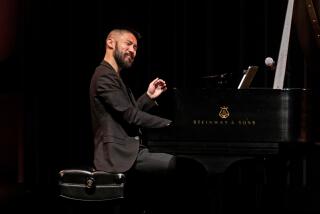MUSIC AND DANCE/Chris Pasles : The Clarinet Concerto --as Mozart Wrote It
- Share via
For nearly 200 years, Mozart’s Clarinet Concerto has been cherished as one of the composer’s last great works, a piece uniquely reflecting autumnal grace and wisdom.
What a surprise to learn that the music usually heard is not exactly what Mozart wrote.
Mozart composed the concerto for an instrument that virtually no longer exists, according to clarinetist David Shifrin. This instrument had an extended lower range of four notes and the composer made full use of this lower range.
Not content to play the usually heard altered version of the concerto, Shifrin, 38, had a special clarinet built to access this range, which he will use to perform the original version of the Mozart work Friday and Saturday at UC Irvine. Shifrin will be backed by the UCI Symphony.
“Mozart wrote the work for his friend Anton Stadler, who was very fond of the low register,” Shifrin said from his home in Milford, Conn. “Stadler experimented with instrument-makers to extend the bottom range of a clarinet by an extra four notes.” This allows the instrument to reach a C below the regular clarinet’s low E.
But the extended-range clarinet never caught on, and Mozart’s publisher, about 10 years after the composer’s death, issued an edited version of the work for today’s more restricted conventional instrument. This is the version that until the 1960s was played in the concert hall. (The orchestra parts did not have to be altered at all because they were not bound by these limits in range.)
Then, according to Shifrin, “compelling evidence” was discovered, which included a review dating from 1802 that criticized the published edition for specific deviations from the original and an early sketch of the first 200 bars of the work, which played down to these lower notes. The major music reference texts confirm Shifrin’s statements.
Shifrin said the published edition “compensates for the lack of these four notes by jumping up an octave in the middle of a melodic line or reversing the direction of an arpeggiated passage or suddenly running out of notes and jumping up an octave while the entire orchestra is continuing in the other direction. . . .
“For many many bars at a time, people will hear the same version they’re used to. Then there will be a very dramatic passage or cascading notes descending down to the low register that can now be filled out instead of being broken in the middle of the passage.
“A few dozen passages scattered throughout the piece make it really quite evident that the instrument makes a big difference in the shape of the piece.”
Shifrin said the discoveries made a major impact on him: “I started over again and relearned the piece. Having this instrument made me . . . rethink some passages and my approach to them--the lyricism of a certain passage, for instance, or the direction of a melodic or a technical passage.
“Certainly, it was worth it to have this instrument made and to relearn and rethink this piece.”
Shifrin described his clarinet, handmade for him in 1983 by Leonard Gulatta, as “a sort of a hybrid.” (Gulatta was head of research for the Selmer Clarinet Co. based in Indiana.)
“It has all of the high end of the range and most of the brilliance of a clarinet, but it has this slightly more mellow quality of sound.”
Shifrin said that the extension in range “does change the timbre of the entire instrument very, very slightly.
“It tends to give the instrument a slightly mellower sound. For such a deep and introspective work, that is consistent with the nature of the piece. I’m sure Mozart had that in mind.”
Shifrin recorded the concerto--along with the Clarinet Quintet, K. 581--with this instrument in 1987.
“Now there are other recordings (using an extended-range clarinet),” he said. “There also have been a number of performances around this year. I’m glad I was one of the first doing this in the country. I perform this version of the piece 30 or 40 times a year.”
“This is the version I really believe in. There is conjecture, which has not been proved, that (an extended clarinet) was intended for use in the Clarinet Quintet. I use it sometimes and have recorded it as a companion with the Concerto.
“Some passages work very well. But I’m not as convinced as I am about the concerto. I’m 100% convinced that this is the right version to play the concerto on.”
David Shifrin will be featured soloist with the UCI Symphony conducted by Zelman Bokser in Mozart’s Clarinet Concerto at 8 p.m. on Friday and Saturday at the UCI Fine Arts Village Theatre. The program will also include Mendelssohn’s “Hebrides” Overture and Tchaikovsky’s “Pathetique” Symphony. Tickets: $4 to $7. Information: (714) 856-5000.
More to Read
The biggest entertainment stories
Get our big stories about Hollywood, film, television, music, arts, culture and more right in your inbox as soon as they publish.
You may occasionally receive promotional content from the Los Angeles Times.










